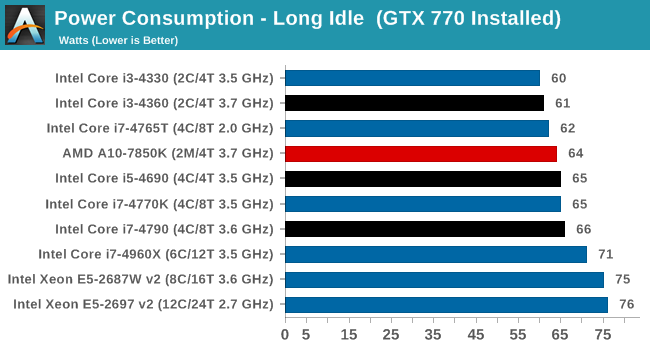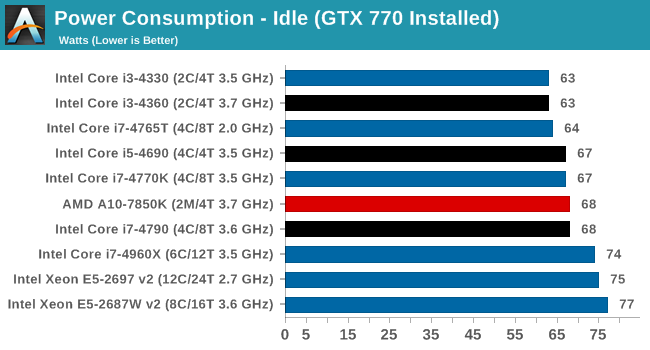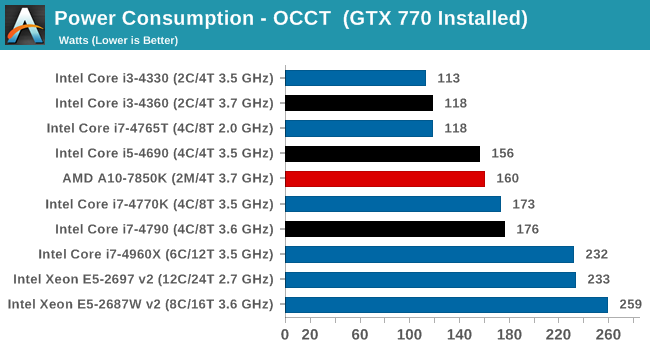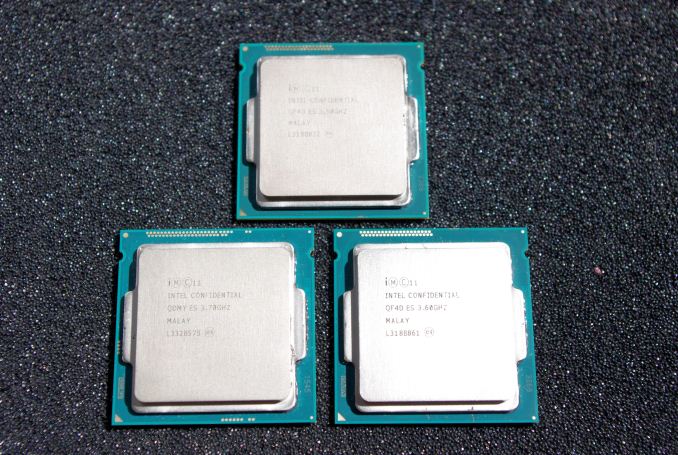The Intel Haswell Refresh Review: Core i7-4790, i5-4690 and i3-4360 Tested
by Ian Cutress on May 11, 2014 3:01 AM ESTThe Haswell Refresh Processors
As a species that thrives on getting things done quicker or cheaper, a processor refresh should be welcomed. For the refresh, Intel is launching a total of 42 new SKUs, 24 of which are desktop but not all of them will make it into the land of retail. Prices for batches of a thousand will range from $42 to $303 on the desktop and $75 to $434 in mobile. Cutting to the chase, the new desktop SKUs are:
| Intel Haswell Refresh CPU List (Desktop) | ||||||||
| New SKU | Cores | Base | Turbo | L3 Cache | IGP | TDP / W |
Intel List Price |
|
| Celeron G1840 | 2 / 2 | 2800 | - | 2 MB | HD (Haswell) | 53 | $42 | |
| Celeron G1840T | 2 / 2 | 2500 | - | 2 MB | HD (Haswell) | 35 | $42 | |
| Celeron G1850 | 2 / 2 | 2900 | - | 2 MB | HD (Haswell) | 53 | $52 | |
| Pentium G3240 | 2 / 2 | 3100 | - | 3 MB | HD (Haswell) | 53 | $64 | |
| Pentium G3240T | 2 / 2 | 2700 | - | 3 MB | HD (Haswell) | 35 | $64 | |
| Pentium G3440 | 2 / 2 | 3300 | - | 3 MB | HD (Haswell) | 53 | $75 | |
| Pentium G3440T | 2 / 2 | 2800 | - | 3 MB | HD (Haswell) | 35 | $75 | |
| Pentium G3450 | 2 / 2 | 3400 | - | 3 MB | HD (Haswell) | 53 | $86 | |
| Core i3-4150 | 2 / 4 | 3500 | - | 3 MB | HD 4400 | 54 | $117 | |
| Core i3-4150T | 2 / 4 | 3000 | - | 3 MB | HD 4400 | 35 | $117 | |
| Core i3-4350 | 2 / 4 | 3600 | - | 4 MB | HD 4600 | 54 | $138 | |
| Core i3-4350T | 2 / 4 | 3100 | - | 4 MB | HD 4600 | 35 | $138 | |
| Core i3-4360 | 2 / 4 | 3700 | - | 4 MB | HD 4600 | 54 | $149 | |
| Core i5-4460 | 4 / 4 | 3200 | 3400 | 6 MB | HD 4600 | 84 | $182 | |
| Core i5-4460S | 4 / 4 | 2900 | - | 6 MB | HD 4600 | 65 | $182 | |
| Core i5-4590 | 4 / 4 | 3300 | 3700 | 6 MB | HD 4600 | 84 | $192 | |
| Core i5-4590S | 4 / 4 | 3000 | 3700 | 6 MB | HD 4600 | 65 | $192 | |
| Core i5-4590T | 4 / 4 | 2000 | - | 6 MB | HD 4600 | 35 | $192 | |
| Core i5-4690 | 4 / 4 | 3500 | 3900 | 6 MB | HD 4600 | 84 | $213 | |
| Core i5-4690S | 4 / 4 | 3200 | 3900 | 6 MB | HD 4600 | 65 | $213 | |
| Core i5-4690T | 4 / 4 | 2500 | - | 6 MB | HD 4600 | 45 | $213 | |
| Core i7-4785T | 4 / 8 | 2200 | - | 8 MB | HD 4600 | 35 | $303 | |
| Core i7-4790 | 4 / 8 | 3600 | 4000 | 8 MB | HD 4600 | 84 | $303 | |
| Core i7-4790S | 4 / 8 | 3200 | 4000 | 8 MB | HD 4600 | 65 | $303 | |
| Core i7-4790T | 4 / 8 | 2700 | - | 8 MB | HD 4600 | 45 | $303 | |
Every new desktop processor is a 100-200 MHz upgrade from the one named xx2x lower but at the same price point. Back when the initial processor price lists were announced, I made different comparisons from Celeron to i7 depending on what was relevant. For example, in the Celeron category:
| Haswell Celeron | ||
|
Celeron G1840 2.8 GHz (New) |
Celeron G1830 2.8 GHz (Current) |
|
| CPU Speed | 2.8 GHz | 2.8 GHz |
| Cores | 2 | 2 |
| Threads | 2 | 2 |
| L2 Cache | 512 KB | 512 KB |
| L3 Cache | 2048 KB | 2048 KB |
| IGP | HD (Haswell) | HD (Haswell) |
| IGP Frequency | ? | 1050 |
| TDP | 53W | 53W |
| Price at Launch | $42 | $52 |
Here we already have a Celeron processor with the exact same speed as one of the Haswell Refresh SKUs, but because it has been on the market for longer it is actually cheaper while providing the same specifications.
At the top end i7, the i7-4790 should actually be a replacement for the i7-4771 which was released in September 2013:
| Haswell Core i7 | ||
|
Core i7-4790 (New) |
Core i7-4771 (Current) |
|
| CPU Speed | 3600 MHz / 4000 MHz | 3500 MHz / 3900 MHz |
| Cores | 4 | 4 |
| Threads | 8 | 8 |
| L2 Cache | 1024 KB | 1024 KB |
| L3 Cache | 8192 KB | 8192 KB |
| IGP | HD 4600 | HD 4600 |
| IGP Frequency | 350 / 1200 MHz | 350 MHz / 1200 MHz |
| TDP | 84W | 84W |
| Price at Launch | $303 | $314 (OEM) / $320 (box) |
By releasing new mainstream processors into the desktop market, as well as the 9-series chipsets, Intel has afforded the system integrators another chance to sell newer systems and not to stagnate with older models.
For most of the performance enthusiasts reading this review, the question you might well be asking yourself relates to the Haswell Refresh overclockable CPU. At this point in time it is clear that the i5-4670K and i7-4770K models do not have refresh counterparts, both of which are also more marketable to system integrators as well as desired by home users. There is a simple explanation to this.
Nothing fundamentally changes with these refresh processors. It is the same design underneath. Now that Intel has been making Haswell wafers, the process is slightly more efficient over time (ironing out production) and the processor bins can all be shifted. If Intel were to release new overclockable CPUs that were a simple speed bump but ultimately had no performance gain of the current overclocking CPUs, there might be a backlash.
To that end, Intel is going to release ‘Devil’s Canyon’ in due course. Devil’s Canyon has no official SKU name yet (i7-4970K or i7-4770X are my best guesses) but it was announced back in March as having an improved package and better thermal interface material. It will probably be the same silicon underneath as the i7-4770K due to the nature of the refresh, perhaps with a small design tweak that does not require new masks. We will review the new overclocking processor when we receive a sample from Intel, hopefully under something suitably extreme.
Today’s Review: The Intel Core i7-4790, i5-4690 and i3-4360
Back when Haswell was launched, we had only the chance to test the top line overclocking processor, the i7-4770K. This time around I was thankful to get the opportunity to expand our testing to the i5 and i3 segments of the processor line to find where they each stand in terms of performance. For comparison points we have the i7-4770K from our launch review, an i7-4765T from our ASRock M8 review, and an i3-4330 we picked up along the way.
| The Intel Haswell Refresh Review | ||||||
|
Core i7-4790 (New) |
Core i7-4770K | Core i7-4765T |
Core i5-4690 (New) |
Core i3-4360 (New) |
Core i3-4330 | |
| Price | $303 | $340 | $303 | $225 | $149 | $140 |
| Launch | 5/2014 | 6/2013 | 6/2013 | 5/2014 | 5/2014 | 9/2013 |
| Cores / Threads | 4/8 | 4/8 | 4/8 | 4/4 | 2/4 | 2/4 |
|
Base Frequency |
3600 | 3500 | 2000 | 3500 | 3700 | 3500 |
|
Turbo Frequency |
4000 | 3900 | 3000 | 3900 | - | - |
| IGP | HD 4600 | HD 4600 | HD 4600 | HD 4600 | HD 4600 | HD 4600 |
|
IGP Frequency |
350 | 350 | 350 | 350 | 600 | 350 |
| IGP Turbo | 1200 | 1250 | 1200 | 1200 | 1150 | 1150 |
| L3 Cache | 8 MB | 8 MB | 8 MB | 6 MB | 4 MB | 4 MB |
| TDP | 84 W | 84 W | 35 W | 84 W | 54 W | 54 W |
Assuming all goes as planned, the small increases in frequency should provide a ~3% increase in benchmarks compared to the older Haswell processors.
Multi-Core Enhancement Isn’t Much Of An Issue
CPU benchmarking can be a bit of a nightmare in the current climate, especially on Intel platforms where turbo modes are possible. Back in 2012 I wrote an extensive news piece about Multi-Core Enhancement titled ‘The Debate About Free MHz’, wherein it is not actually Intel that set the CPU frequency for the processors but the motherboard. Where Intel might have a 3500 MHz base frequency and a 3900 MHz turbo frequency, a motherboard can detect that setting and override it for 3900 MHz on all cores by default. One motherboard went as far as increasing the multiplier +1 over the Intel specifications. The upshot of this is in multi-threaded performance benchmarks, where due to the extra frequency the final result is higher than Intel specifications. MultiCore Enhancement also means that the same CPU in different motherboards will give different results out of the box.
Most motherboard manufacturers that use this tactic (MSI, ASRock, GIGABYTE and ASUS all have this feature), as far as I can tell, limit the option to overclockable SKUs, and it is only implemented when XMP is implemented.
On top of this, Windows can also be a culprit. In different power modes, users can specify the percentage of maximum CPU frequency depending on what power mode is in play. This relates more to portable devices, but it is configurable with desktop systems as well.
For our review, as we only have one overclockable CPU in the test, we can adjust appropriately. For our testing we actually run SYSMark 2014 as our first benchmark, as the install prefers a fresh OS image to work with. This generates a consistent power profile which we maintain for the rest of the benchmarks. Had we run SYSMark mid-way through our testing period, it may have ended up with variable results, so we aim to keep our environment consistent and maintainable.
Test Setup
We would like to thank the following companies for providing test-bed support:
Thank you to OCZ for providing us with PSUs and SSDs.
Thank you to G.Skill and ADATA for providing us with memory kits.
Thank you to Corsair for providing us with an PSU, CLC and memory.
Thank you to ASUS for providing us with the AMD HD7970 GPUs and some IO Testing kit.
Thank you to MSI for providing us with the NVIDIA GTX 770 Lightning GPUs.
Thank you to Rosewill for providing us with keyboards.
Thank you to ASRock for providing us with the 802.11ac wireless router for testing and other components.
| Test Setup | |
| Processor |
Intel Core i7-4790 ES (4C/8T, 3.6 GHz to 4.0 GHz) Intel Core i5-4690 ES (4C/4T, 3.5 GHz to 3.9 GHz) Intel Core i3-4360 ES (2C/4T, 3.7 GHz) |
| Motherboards |
ASRock Z97 Extreme6 ASUS Z97-Deluxe |
| Cooling |
Corsair H80i Thermalright TRUE Copper |
| Power Supply |
OCZ 1250W Gold ZX Series Corsair AX1200i Platinum PSU |
| Memory |
G.Skill RipjawsZ 4x4 GB DDR3-1866 8-9-9 Kit ADATA XPG 2x8 GB DDR3L-1600 9-11-9 Kit |
| Memory Settings | 1600 9-11-9-27 1T tRFC 240 |
| Video Cards |
MSI GTX 770 Lightning 2GB (1150/1202 Boost) ASUS HD7970 3GB (Reference) |
| Video Drivers |
Catalyst 13.12 WHQL NVIDIA Drivers 335.23 WHQL |
| Hard Drive | OCZ Vertex 3 256GB |
| Optical Drive | LG GH22NS50 |
| Case | Open Test Bed |
| Operating System | Windows 7 64-bit SP1 |
Following recent reviews, we have added several new benchmarks to our testing, including SYSMark and Unity-based testing methodology. At present we have only tested a few CPUs on these new benchmarks.
Power Consumption
For our power consumption tests, we take the system as a whole with a GTX 770 installed and test at idle, long idle (monitor turned off by the OS) and OCCT (artificial CPU load). We use the same PSU to keep efficiency on the same scale, although some of the data points are sub-20% efficienct for our power supply. This means that arbitrarily the qualitative comparison is more important than the quantitative comparison. Also of note is the Z97 motherboard we used for these tests implements an Adaptive voltage profile, meaning that artificial loads such as OCCT push the voltage higher than normal, increasing power consumption at load. Nevertheless the order of the results indicates a pattern from low power to high power.



As expected, the 84W i7-4790 requires the most power, similar to the i7-4770K and i5-4690 that are also 84W.












130 Comments
View All Comments
MrSpadge - Monday, May 12, 2014 - link
Am I the only one to notice that especially in the first benchmarks the 4790 often outperforms the 4770K by ~6%, sometimes even by 11% (e.g. the very first benchmark)? Veryfiying an expected lack of improvement is nice, but not even commenting on such discrepancies seems.. not like usual Anandtech quality. If I were you I'd repeat those benchmarks and - if verified - would try to find the reason for the 4790 (sometimes) performing significantly better than expected.stephenbrooks - Saturday, May 24, 2014 - link
Yes, that's weird: the improvement is greater than the clock bump.RickyBaby - Monday, May 12, 2014 - link
So, would like to thank Ian on another job well done. A thankless job no doubt, as per the discussions this was a purely marketing driven release and offered essentially nothing of value. I did have one question though. And as background, I, like it appears most here are running and older, home built rigs like I am. Rigs built several generations ago which compete very well with today's rigs.I am an over-clocker from way back and like to squeeze out a little extra performance ... just to know that I haven't been cheated, lol. JK. Anyway, I'm thinking of buying a i3 and overclocking it what little I can or even go for an i5 - K chip. So, what overclocking options are available any more. ANY ???
The multi-core enhancement question for K processors was not answered in this article. Does it work on the 97 chipset with the new haswell's or not ??? And the does the limited bclk overclocking work ? Again, i3 (locked) and 97 chipset, does it work or not ? I'm sure that I'm not the only to realize that a 3.7 i3 with a bclk of 108 would be a cool 4.0 ghz. And that my friends is locked at 4.0. 1 cpu, 2 cpus, and even 3 and 4 via ht and all at 4.0 ghz. Since i5s and i7s throttle down depending on # CPUs being utilized ... up until more than 4, it seems that an i3 would kick ass. And here is where most could agree. Do I do ANYTHING that requires more than 4 cpus, 100% clocked at 4 ghz for large stretches of time ? NO. I. DO. NOT. And the difference in cache between an i3 (4mb) and an i7 (6mb) is again pretty much meaningless. Anyone know the diff in hit rates? 96% vs 97% ? So and even slightly overclocked i3 would make for an enticing $ proposition.
But this all gets ignored. Ian, care to address the overclocking situation in a follow up article ? And no, I'm not referring to Devils Canyon or the unlocked Pent; which is core limited (2, no HT) and cache limited. But for people who buy an non-K haswell. What options do they have and does it make a real difference ? I do wonder what intel would think if an i3 overclocked just a little bit would out perform every stock i5 and i7 though. Probably not a happy camper.
Antronman - Tuesday, May 13, 2014 - link
K series is core unlocked. Overclock it or underclock it to any clock rate you want.Non-K is core locked, you can only use turbo boost which is a very small increase in clock.
RickyBaby - Tuesday, May 13, 2014 - link
Sorry but you didn't answer the question. Can anyone ? Or is this some sort of no-no answer that everyone is supposed to give to satisfy the GIANT in the room. That GIANT of course being Intel.So why the confusion? Here is why, Toms just did a roundup of some of the new mobos and addresses overclocking. On that section (page 23 I believe) there are 3 charts. The middle chart gives the maximum base clocks for each of the motherboards on each of the 3 strap settings. The Gigabyte mobo reached a bclock of 114 with the strap set to 100. Which is the default and is unchangeable on non-k chips. You cannot change the strap but I do believe that you can change the clock. Would that not be a 14% overclock. If not, why not. The comment on the the Tom's page again seems to imply but not out and out claim you could overclock ANY locked CPU by 14% using that board. Here is exactly what he said:
"the Z79X Gaming 5 reached the highest base clock frequency when using the 100 MHz strap. That’s the only ratio available on multiplier-locked processors, so this might be important to anyone running the new Core i7-4790"
Why would that be important ? Because the 4790 is not a K and is therefore locked. But you could still overclock it by 14% .. which is how I read that.
And Tom's again muddies the waters. In that same article in review of the ASUS board on the 3rd page it talks about bios settings for overclocking and the use of the XMP setting. Again a quote:
"Unless you're using a K-series CPU, overclocking is limited to a handful of 100 MHz speed bins over stock. So, we reverted to our Core i7-4770K to test it."
So does XMP, multi-core enhancement still exist and still work for NON-K cpus ? Apparently it does. With the latest chipset (97) and latest chips (4th gen) too.
Sorry but I wish someone would just come out and say it. If your board supports BCLK increases then you can overclock to that amount. Not that is not a lot; most boards i've seen are 5%-7%. And if your chips supports Turbo then XMP/Mult Core Ehancement is alive and well too. So take an i5, increase bck by 10% and lock your Max Turbo using XMP and you'd have a decent overclock of 15%-20% under a heavy load.
I'm just waiting for someone (like Ian) to confirm/deny that the above is true.
MrSpadge - Tuesday, May 13, 2014 - link
Ricky, your concern is very valid! When Haswell launched I had hoped to get i7 4770R with Crystalwell L4 cache and to be able to set all cores to 3.9 GHz (max single core turbo), unlimited power consumption and a BCLK of 102.5 - 107.5 MHz for 4.0 - 4.2 GHz. This could run at very energy efficient ~1.00 V and would outperform pretty much every other quad core if the L4 works well (>10% performance per clock) and otherwise still be decent. Without any heat problems (power consumption would probably be below a stock 4770).BUT there were reports of multi core enhancement not working for non-K models. Which renders such a plan useless, before I even get to the point that you can not buy 4770R soldered onto a regular mainboard (just those notebook-expensive mini boxes).
JokerProductions - Tuesday, May 13, 2014 - link
Still the same horrible 1150 socket, but now with a 2% performance gain. Yay! Still waiting on X99 and my 8 core.eanazag - Tuesday, May 13, 2014 - link
Finally some bench love. I see the scores are in the bench. I'd like to see some updates to what AMD is still selling as far as the bench apps tested. Like comparing the FX 8350 with the new Haswells gets rough with limited apps that line up.The|Hunter - Tuesday, May 13, 2014 - link
btw Intel confirmed Broadwell and Z87 compatibility back in September 2013;One intel ceo/rep said: "Broadwell is going to enable 2 types of devices, One you can plug the chips directly into existing systems (z87) and Second we will have brand new systems with broad new range of fanless designs.."
https://www.youtube.com/watch?feature=player_detai...
*z87 and devil canyon needed IMEI uefi firmware update..
jjjag - Wednesday, May 14, 2014 - link
Desktops ARE dying. Stop saying they are not. Desktop silicon is exactly the same as mobile silicon, and has been for several generations. The number of SKUs that are sold into desktop has been rapidly declining, driven by the declining number of desktop computers that are offered by people like Dell and HP, which of course is driven by demand.HEDT, a.k.a. "Extreme", is different silicon than mobil/desktop since the 2nd gen. Core parts. These are server parts that are de-featured and re-badged as desktop. The volumes are too small and declining to justify these for much longer.
To answer another's question: you will not see a desktop with Iris Pro until Broadwell. Unless you count that little Gigabyte box that uses the Haswell Iris Pro.
To respond to another. Intel is not sabotaging anything. To believe that is ignorant. It's all driven by demand. Once demand drops below a certain level, it does not make business sense to sell a particular part.